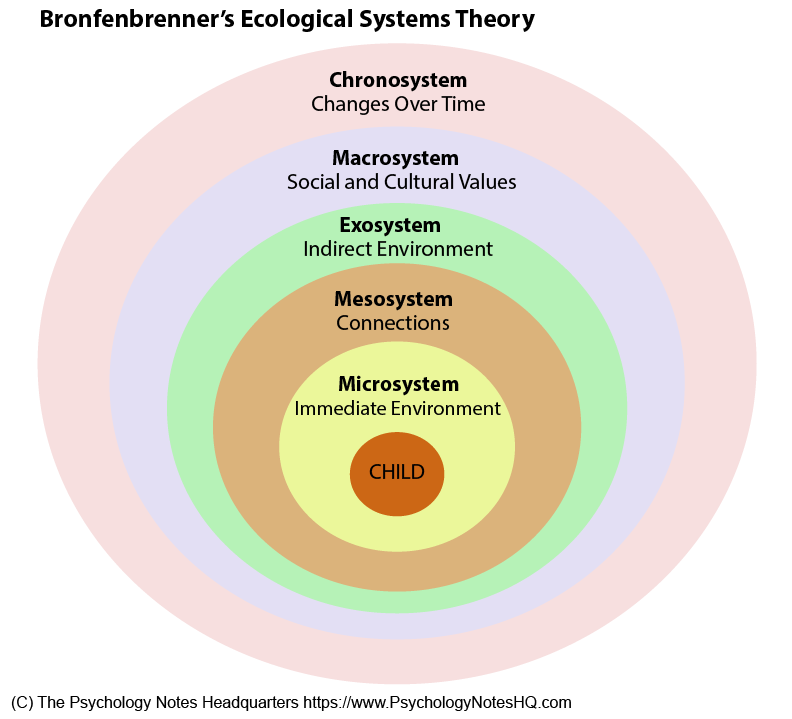
Reproduced from: https://www.psychologynoteshq.com/bronfenbrenner-ecological-theory/
The micro system “is a pattern of activities, roles, and institutional relations experienced by the developing person in a given setting with particular physical and material characteristics” (Bronfenbrenner, 1979, p. 22). It refers to the smallest unit of assessment and intervention, and includes the the individual, family, day-care, school, work in which the person directly interacts. In working at the micro level social workers are more likely to engage people in counselling, therapy, and provide material assistance and referrals. The reference to “experienced” by the person, refers to the fact that it is not only the objective properties of the setting that influence development; the individual’s subjective meanings attached to situations are just as important, reflecting an alignment with phenomenological and social constructivist approaches.
Meso/mezzo system – involves interactions between and across the various micro systems e.g. a parent’s engagement with schools, hospitals, associations, self-help groups. Assessment and interventions might rest at the level of micro systems, or they might include group and community based interventions in recognition of the interdependencies across the various systems.
Exo-system – does not involve the developing person as an active participant but has profound influences. E.g. parents’ flexibility of work hours; maternity & paternity leave; and medical insurance do influence the development of a child.
Macro-system – refers to “consistencies, in the form and content of lower-order systems (micro, meso, and exo) that exist, or could exist, at the level of the subculture or the culture as a whole, along with any belief systems or ideology underlying such consistencies” (Bronfenbrenner, 1979, p. 26). While the welfare state of Norway, e.g. reflects consistency at any given time in terms of laws and regulations, how these play out in the lives of individuals and families may vary a great deal. Macro systems are larger or supra systems that surround smaller systems. The blueprints of these macro systems manifest in ways where “homes, day care centres, neighborhoods, work settings, and the relations between them are not the same for well-to-do families as for the poor” (Bronfenbrenner, 1979, p. 26). Interventions at this level might include macro level strategies such as policy formulations and change, advocacy and lobbying.
Chronosystem – provides for an historical dimension of people’s development. A useful tool is the time-line. This allows for the charting of what Bronfenbrenner (1979) called “ecological transitions” i.e. “shifts in role or setting which occur throughout the life span” (p. 6).
Homeostasis – processes and mechanisms used by systems to maintain a relatively steady state.
Equilibrium – when the system has reached a state of balance.
Equifinality – a system may achieve the same results from different initial conditions and by various means.
Boundaries are “the repeatedly occurring patterns of behavior that characterize the relationships within a system and give that system a particular identity” (Zastrow and Kirst-Ashman, 2001, p. 5); it also characterizes relationships across systems and reflect and influence the amount of energy (information, resources & people) exchanged within and between systems. All boundaries according to Von Bertalanffy (1968) are “ultimately dynamic … and is never completely fixed” (p. 116). Closed, open and diffused boundaries have been widely used in social work, particularly in the field of family therapy. Closed or relatively closed boundaries (there is no such thing as a fully closed boundary) are generally associated with disengaged relationships; open boundaries with appropriate relationships and clear communication; and diffused boundaries with over-involved, inappropriate and enmeshed relationships. There are plenty of examples on the Internet about the use and application of these concepts with genograms and ecomaps, and symbols used to represent different types of relationships. Ann Hartman made the initial contributions to this. See e.g.
Hartman Diagrammatic Assessment of Family Relationships.pdf
Exchange – interaction between systems through which resources are shared. Resources or information into systems are called inputs, which are processed and used to produce outputs.
Network – patterned relationships between systems – regular exchange of inputs and outputs – can facilitate coordination and maximum use of resources
Status – one’s actual position in society
Role – dynamic aspect of status i.e. how one enacts or fulfils one’s position.
The ecological-systems approach has been used to understand the inter-relationship between humans, social systems and the natural geographic environment in relation to contemporary concerns around global warming and climate change, in what is called green social work (Dominelli, 2012).